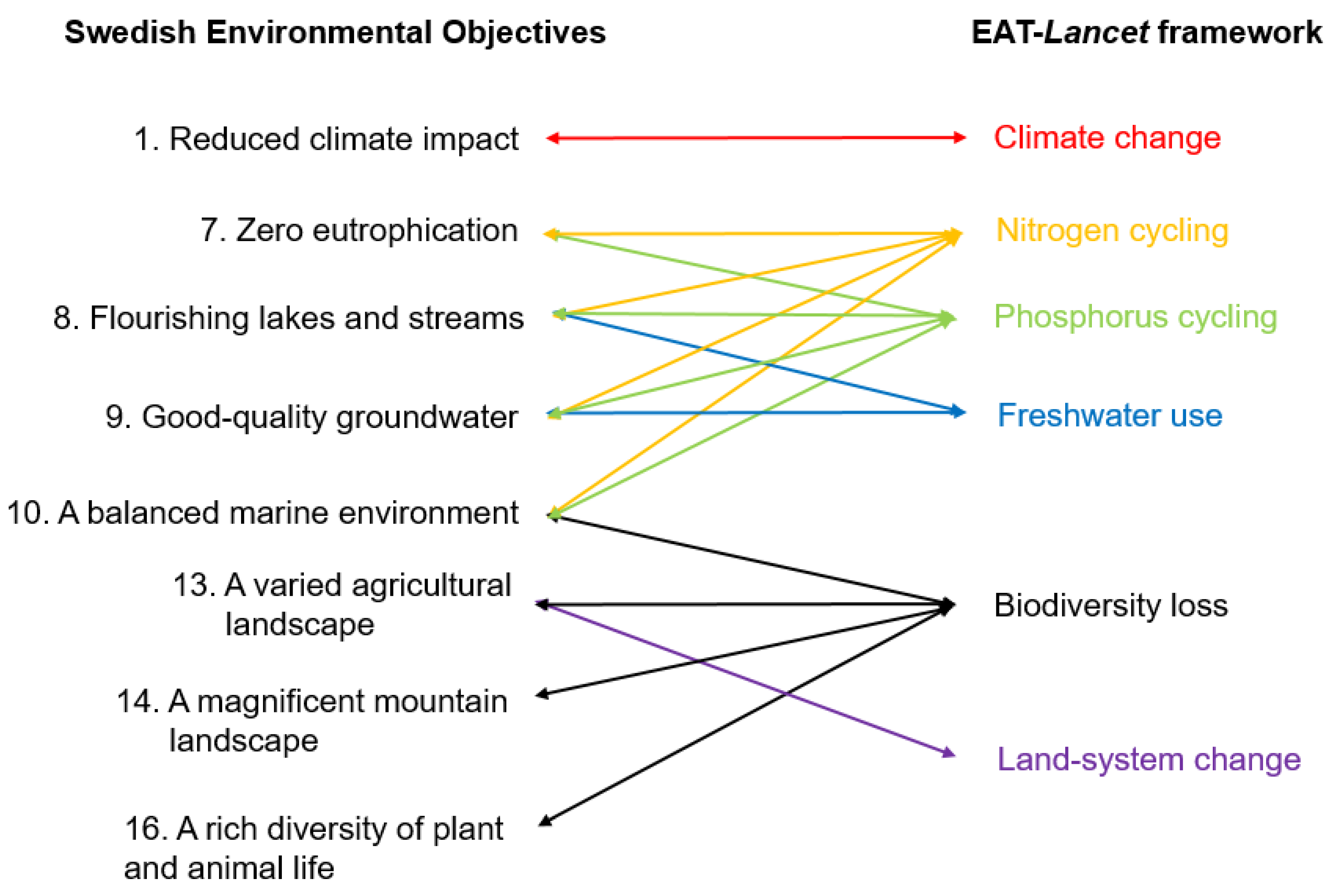Benchmarking the Swedish Diet Relative to Global and National Environmental Targets—Identification of Indicator Limitations and Data Gaps
Abstract
1. Introduction
2. Materials and Methods
2.1. Data on Food Supply for the Average Swedish Diet
2.2. Global Boundaries, Indicators and Inventory Data
2.2.1. Climate Change
2.2.2. Land-System Change
2.2.3. Nitrogen and Phosphorus Cycling
2.2.4. Freshwater Use
2.2.5. Biodiversity Loss
2.3. Downscaling of the Global Boundaries
2.4. Comparisons of Global and Local Indicators and Boundaries
3. Results and Discussion
3.1. Benchmarking the Environmental Impacts of the Average Swedish Diet Relative to Global Boundaries
3.2. Relative Contribution of Foods to Environmental Impacts of the Average Swedish Diet
3.3. Comparison of Global and Local Indicators and Boundaries
3.3.1. Climate Change
3.3.2. Land-System Change
3.3.3. Nitrogen and Phosphorus Cycling
3.3.4. Freshwater Use
3.3.5. Biodiversity Loss
3.3.6. Additional Aspects not Captured by the EAT-Lancet Framework
3.3.7. Summary of Comparisons of Global and Local Frameworks and Suggested Indicators
3.4. Study Limitations
4. Conclusions
Supplementary Materials
Author Contributions
Funding
Acknowledgments
Conflicts of Interest
References
- Willett, W.; Rockström, J.; Loken, B.; Springmann, M.; Lang, T.; Vermeulen, S.; Garnett, T.; Tilman, D.; DeClerck, F.; Wood, A.; et al. Food in the Anthropocene: The EAT–Lancet Commission on healthy diets from sustainable food systems. Lancet 2019, 393, 447–492. [Google Scholar] [CrossRef]
- Vermeulen, S.J.; Campbell, B.M.; Ingram, J.S. Climate change and food systems. Annu. Rev. Environ. Resour. 2012, 37, 195. [Google Scholar] [CrossRef]
- FAO. FAOSTAT Statistical Database; Food and Agricultural Organization of the United Nations: Rome, Italy, 2019. [Google Scholar]
- Cederberg, C.; Persson, U.M.; Schmidt, S.; Hedenus, F.; Woodl, R. Beyond the borders–burdens of Swedish food consumption due to agrochemicals, greenhouse gases and land-use change. J. Clean. Prod. 2019, 214, 644–652. [Google Scholar] [CrossRef]
- Burlingame, B.; Dernini, S. Sustainable Diets and Biodiversity: Directions and Solutions for Policy, Research and Action. In Proceedings of the International Scientific Symposium, Biodiversity and Sustainable Diets United Against Hunger, FAO Headquarters, Rome, Italy, 3–5 November 2010; Food and Agriculture Organization of the United Nations (FAO): Rome, Italy, 2012. [Google Scholar]
- Chai, B.C.; van der Voort, J.R.; Grofelnik, K.; Eliasdottir, H.G.; Klöss, I.; Perez-Cueto, F.J.A. Which Diet Has the Least Environmental Impact on Our Planet? A Systematic Review of Vegan, Vegetarian and Omnivorous Diets. Sustainability 2019, 11, 4110. [Google Scholar] [CrossRef]
- Clark, M.; Tilman, D. Comparative analysis of environmental impacts of agricultural production systems, agricultural input efficiency, and food choice. Environ. Res. Lett. 2017, 12, 064016. [Google Scholar] [CrossRef]
- Springmann, M.; Clark, M.; Mason-D’Croz, D.; Wiebe, K.; Bodirsky, B.L.; Lassaletta, L.; de Vries, W.; Vermeulen, S.J.; Herrero, M.; Carlson, K.M.; et al. Options for keeping the food system within environmental limits. Nature 2018, 562, 519–525. [Google Scholar] [CrossRef]
- Hallström, E.; Carlsson-Kanyama, A.; Börjesson, P. Environmental impact of dietary change: A systematic review. J. Clean. Prod. 2015, 91, 1–11. [Google Scholar] [CrossRef]
- Martin, M.; Brandão, M. Evaluating the Environmental Consequences of Swedish Food Consumption and Dietary Choices. Sustainability 2017, 9, 2227. [Google Scholar] [CrossRef]
- Swedish Board of Agriculture. Konsumtion och Förbrukning av Kött 2019. Available online: http://www.jordbruksverket.se/amnesomraden/konsument/livsmedelskonsumtionisiffror/kottkonsumtionen.4.465e4964142dbfe44705198.html (accessed on 4 October 2019).
- Swedish Board of Agriculture. Marknadsrapport Mjölk och Mejeriprodukter—Utvecklingen Till och Med 2018; Swedish Board of Agriculture: Jönköping, Sweden, 2019. [Google Scholar]
- WWF. One Planet Plate 2019—Kriterier och Bakgrund; WWF: Stockholm, Sweden, 2019. [Google Scholar]
- Röös, E.; Karlsson, H.; Witthöft, C.; Sundberg, C. Evaluating the sustainability of diets–combining environmental and nutritional aspects. Environ. Sci. Policy 2015, 47, 157–166. [Google Scholar] [CrossRef]
- Jones, A.D.; Hoey, L.; Blesh, J.; Miller, L.; Green, A.; Shapiro, L.F. A systematic review of the measurement of sustainable diets. Adv. Nutr. 2016, 7, 641–664. [Google Scholar] [CrossRef]
- Ridoutt, B.G.; Hendrie, G.A.; Noakes, M. Dietary strategies to reduce environmental impact: A critical review of the evidence base. Adv. Nutr. 2017, 8, 933–946. [Google Scholar] [CrossRef] [PubMed]
- Sveriges Miljömål. Sveriges Miljömål. 2019. Available online: http://www.sverigesmiljomal.se/ (accessed on 4 November 2019).
- SBA. Statistical Database; Swedish Board of Agriculture: Jönköping, Sweden, 2019. [Google Scholar]
- Eidstedt, M. (Swedish Board of Agriculture, Jönköping, Sweden). Personal communication, 2018.
- Swedish National Food Agency. The Food Database; Swedish National Food Agency: Uppsala, Sweden, 2019; Available online: http://www7.slv.se/SokNaringsinnehall/ (accessed on 10 May 2019).
- Notarnicola, B.; Tassielli, G.; Nicoletti, G. Life cycle assessment (LCA) of wine production. Environ. Friendly Food Process. 2003, 306, 326. [Google Scholar]
- Garnett, T. The Alcohol We Drink and Its Contribution to the UK’s Greenhouse Gas Emissions: A Discussion Paper; Centre for Environmental Strategy, University of Surrey: London, UK, 2007. [Google Scholar]
- Röös, E. Mat-Klimat-Listan; Department of Energy and Technology, Swedish University of Agricultural Sciences: Uppsala, Sweden, 2014. [Google Scholar]
- Steffen, W.; Richardson, K.; Rockström, J.; Cornell, S.E.; Fetzer, I.; Bennett, E.M.; Biggs, R.; Carpenter, S.R.; de Vries, W.; de Wit, C.A.; et al. Planetary boundaries: Guiding human development on a changing planet. Science 2015, 347, 1259855. [Google Scholar] [CrossRef] [PubMed]
- Rockström, J.; Steffen, W.; Noone, K.; Persson, Å.; Chapin, S., III; Lambin, E.F.; Lenton, T.M.; Scheffer, M.; Folke, C.; Schellnhuber, H.J.; et al. A safe operating space for humanity. Nature 2009, 461, 472–475. [Google Scholar] [CrossRef]
- Moberg, E.; Andersson, M.W.; Säll, S.; Hansson, P.-A.; Röös, E. Determining the climate impact of food for use in a climate tax—Design of a consistent and transparent model. Int. J. Life Cycle Assess. 2019, 24, 1715–1728. [Google Scholar] [CrossRef]
- Swedish Board of Agriculture. Energianvändning i Växthus 2017. Tomat, Gurka och Prydnadsväxter. Greenhouse Energy Use in 2017; Swedish Board of Agriculture: Jönköping, Sweden, 2018. [Google Scholar]
- Velden, N.; Smit, P. Energiemonitor van de Nederlandse Glastuinbouw 2016; LEI Wageningen UR (University & Research Centre): Wageningen, The Netherlands, 2017. [Google Scholar]
- Velden, N.; Smit, P. Energiemonitor van de Nederlandse Glastuinbouw 2017; LEI Wageningen UR (University & Research Centre): Wageningen, The Netherlands, 2018. [Google Scholar]
- Statistics Sweden. Statistical Database; Statistics Sweden: Stockholm, Sweden, 2019. [Google Scholar]
- Kailis, S.; Harris, D.J. Producing Table Olives; Landlinks Press: Collingwood, Australia, 2007. [Google Scholar]
- Cederberg, C.; Meyer, D.; Flysjö, A. Life Cycle Inventory of Greenhouse Gas Emissions and Use of Land and Energy in Brazilian Beef Production; SIK Institutet för Livsmedel och Bioteknik: Gothenburg, Sweden, 2009. [Google Scholar]
- Nemecek, T.; Bengoa, X.; Lansche, J.; Mouron, P.; Riedener, E.; Rossi, V.; Humbert, S. World Food LCA Database: Methodological Guidelines for the Life Cycle Inventory of Agricultural Products. Version 3.0.; World Food LCA Database (WFLDB), Quantis and Agroscope: Lausanne and Zurich, Switzerland, 2015. [Google Scholar]
- Ecoinvent Centre. Ecoinvent Database Version 3.5.; Swiss Centre for Life Cycle Inventories: Dübendorf, Switzerland, 2018. [Google Scholar]
- Ledgard, S.F.; Lieffering, M.; Coup, D.; O’Brien, B. Carbon footprinting of New Zealand lamb from the perspective of an exporting nation. Anim. Front. 2011, 1, 40–45. [Google Scholar] [CrossRef]
- Kendall, A.; Yuan, J.; Brodt, S.B. Carbon footprint and air emissions inventories for US honey production: Case studies. Int. J. Life Cycle Assess. 2013, 18, 392–400. [Google Scholar] [CrossRef]
- Hallström, E.; Håkansson, N.; Åkesson, A.; Wolk, A.; Sonesson, U. Climate impact of alcohol consumption in Sweden. J. Clean. Prod. 2018, 201, 287–294. [Google Scholar] [CrossRef]
- O’Brien, D.; Bohan, A.; McHugh, N.; Shalloo, L. A life cycle assessment of the effect of intensification on the environmental impacts and resource use of grass-based sheep farming. Agric. Syst. 2016, 148, 95–104. [Google Scholar] [CrossRef]
- Wallman, M.; Cederberg, C.; Sonesson, U. Life Cycle Assessment of Swedish Lamb Production; SIK Rapport; SIK Institutet för Livsmedel och Bioteknik: Gothenburg, Sweden, 2011. [Google Scholar]
- Nilsson, K.; Sund, V.; Florén, B. The Environmental Impact of the Consumption of Sweets, Crisps and Soft Drinks; Nordic Council of Ministers: Copenhagen, Denmark, 2011. [Google Scholar]
- Landqvist, B.; Woodhouse, A. Klimatavtryck av Rotfrukter, Grönsaker och Kryddor: Analys av 10 Produkter Odlade i Sverige; SIK Rapport; SIK Institutet för Livsmedel och Bioteknik: Gothenburg, Sweden, 2014. [Google Scholar]
- Chapagain, A.K.; Hoekstra, A.Y. The water footprint of coffee and tea consumption in the Netherlands. Ecol. Econ. 2007, 64, 109–118. [Google Scholar] [CrossRef]
- Alsterberg, E. Animaliska Restprodukter vid Köttproduktion: Effektiv Användning och Livsmedelspotential; Teknisk-naturvetenskaplig fakultet, UTH-enheten, Uppsala University: Uppsala, Sweden, 2012. [Google Scholar]
- Clune, S.; Crossin, E.; Verghese, K. Systematic review of greenhouse gas emissions for different fresh food categories. J. Clean. Prod. 2017, 140, 766–783. [Google Scholar] [CrossRef]
- Gustavsson, J.; Cederberg, C.; Sonesson, U. Global Food Losses and Food Waste; FAO: Rome, Italy, 2011. [Google Scholar]
- Nilsson, K.; Flysjö, A.; Davis, J.; Sim, S.; Unger, N.; Bell, S. Comparative life cycle assessment of margarine and butter consumed in the UK, Germany and France. Int. J. Life Cycle Assess. 2010, 15, 916–926. [Google Scholar] [CrossRef]
- Flysjö, A.; Cederberg, C.; Strid, I. LCA-Databas för Konventionella Fodermedel: Miljöpåverkan i Samband Med Produktion; SIK Institutet för Livsmedel och Bioteknik: Uppsala and Gothenburg, Sweden, 2008. [Google Scholar]
- Poore, J.; Nemecek, T. Reducing food’s environmental impacts through producers and consumers. Science 2018, 360, 987–992. [Google Scholar] [CrossRef] [PubMed]
- FAO. Definition and Classification of Commodities, 5. Nuts and Derived Products; Food and Agricultural Organization of the United Nations: Rome, Italy, 1994. [Google Scholar]
- FAO. Definition and Classification of Commodities, 6. Oil-Bearing Crops and Derived Products; Food and Agricultural Organization of the United Nations: Rome, Italy, 1994. [Google Scholar]
- Swedish Board of Agriculture. Marknadsrapport FÅR & LAMM—Utvecklingen Till och Med 2018; Swedish Board of Agriculture: Jönköping, Sweden, 2019. [Google Scholar]
- Swedish Board of Agriculture. Marknadsöversikt Potatis Till Mat och Stärkelseproduktion; Fredagsmys och Husmanskost, Swedish Board of Agriculture: Jönköping, Sweden, 2015. [Google Scholar]
- Swedish Board of Agriculture. Bli Biodlare—Utveckla Ditt Företag; Swedish Board of Agriculture: Jönköping, Sweden, 2011. [Google Scholar]
- Swedish Alcohol Monopoly. Swedish Alcohol Monopoly Sales Statistics. 2019. Available online: https://www.systembolaget.se/om-systembolaget/om-foretaget/forsaljningsstatistik/ (accessed on 4 November 2019).
- Alfsdotter, A.-S.; (Swedish Beekeepers Association, Skänninge, Sweden). Personal communication, 2019.
- European Commission. EU Beekeeping Sector. National Apiculture Programmes 2020–2022; European Commission: Brussels, Belgium; Available online: https://ec.europa.eu/info/sites/info/files/food-farming-fisheries/animals_and_animal_products/presentations/national-apiculture-programmes_en.pdf (accessed on 4 November 2019).
- Lassaletta, L.; Billen, G.; Grizzetti, B.; Anglade, J.; Garnier, J. 50 year trends in nitrogen use efficiency of world cropping systems: The relationship between yield and nitrogen input to cropland. Environ. Res. Lett. 2014, 9, 105011. [Google Scholar] [CrossRef]
- Cederberg, C.; Nilsson, B. Livscykelanalys (LCA) av Ekologisk Nötköttsproduktion i Ranchdrift; SIK Institutet för Livsmedel och Bioteknik: Gothenburg, Sweden, 2004. [Google Scholar]
- Ministerio de Medio Ambiente y Medio Rural y Marino. Guía Práctica de la Fertilización Racional de los Cultivos en España. Abonado de los Principales Cultivos en España; Ministerio de Medio Ambiente y Medio Rural y Marino, Gobierno de España: Madrid, Spain; Available online: https://www.mapa.gob.es/es/agricultura/publicaciones/02_FERTILIZACI%C3%93N(BAJA)_tcm30-57891.pdf (accessed on 4 October 2019).
- Marmolin, C.; Björkholm, A.-M. Växtnäringsrekommendationer Till Frilandsgrönsaker En Sammanställning av Rekommendationer Som Ges i Sverige, Norge, Finland, Tyskland, Holland och UK; Hushållningssällskapet: Skara and Kristianstad, Sweden, 2014. [Google Scholar]
- Nilsson, T. Gödsling av Hallon. LTJ-Fakultetens Faktablad; Fakulteten för Landskapsplanering, Trädgårds-Och Jordbruksvetenskap, Swedish University of Agricultural Sciences: Alnarp, Sweden, 2011. [Google Scholar]
- Swedish Board of Agriculture. Gödslings-Och Kalkningsråd för Fruktodling 2004; Swedish Board of Agriculture: Jönköping, Sweden, 2004. [Google Scholar]
- Spruijt, J.; van der Voort, M. Kwantitatieve Informatie Akkerbouw en Vollegrondsgroenteteelt 2015; Wageningen University & Research: Wageningen, The Netherlands, 2015. [Google Scholar]
- Blengini, G.A.; Busto, M. The life cycle of rice: LCA of alternative agri-food chain management systems in Vercelli (Italy). J. Environ. Manag. 2009, 90, 1512–1522. [Google Scholar] [CrossRef]
- Fusi, F.; Bacenetti, J.; González-García, S.; Vercesi, A.; Bocchi, S.; Fiala, M. Environmental profile of paddy rice cultivation with different straw management. Sci. Total Environ. 2014, 494, 119–128. [Google Scholar] [CrossRef]
- Röös, E.; Karlsson, H. Effect of eating seasonal on the carbon footprint of Swedish vegetable consumption. J. Clean. Prod. 2013, 59, 63–72. [Google Scholar] [CrossRef]
- Davis, J. Emissions of Greenhouse Gases from Production of Horticultural Products: Analysis of 17 Products Cultivated in Sweden; SIK Institutet för Livsmedel och Bioteknik: Gothenburg, Sweden, 2011. [Google Scholar]
- Mekonnen, M.M.; Hoekstra, A.Y. A global assessment of the water footprint of farm animal products. Ecosystems 2012, 15, 401–415. [Google Scholar] [CrossRef]
- Mekonnen, M.M.; Hoekstra, A.Y. The green, blue and grey water footprint of crops and derived crop products. Hydrol. Earth Syst. Sci. 2011, 15, 1577–1600. [Google Scholar] [CrossRef]
- Chaudhary, A.; Brooks, T.M. Land use intensity-specific global characterization factors to assess product biodiversity footprints. Environ. Sci. Technol. 2018, 52, 5094–5104. [Google Scholar] [CrossRef]
- Ritchie, H.; Roser, M. Land Use. In Our World in Data; 2020; Available online: https://ourworldindata.org/land-use (accessed on 4 October 2019).
- Burgin, C.J.; Colella, J.P.; Kahn, P.L.; Upham, N.S. How many species of mammals are there? J. Mammal. 2018, 99, 1–14. [Google Scholar] [CrossRef]
- Dickinson, E.C.; Remsen, J.V.J. The Howard and Moore Complete Checklist of the Birds of the World, 4th ed.; Non-Passerines, Aves Press: Eastbourne, UK, 2013; Volume 1. [Google Scholar]
- Dickinson, E.C.; Christidis, L. The Howard and Moore Complete Checklist of the Birds of the World, 4th ed.; Non-Passerines, Aves Press: Eastbourne, UK, 2014; Volume 2. [Google Scholar]
- Pincheira-Donoso, D.; Bauer, A.M.; Meiri, S.; Uetz, P. Global taxonomic diversity of living reptiles. PLoS ONE 2013, 8, e59741. [Google Scholar] [CrossRef] [PubMed]
- Frost, D.R.; Grant, T.; Faivovich, J.; Bain, R.H.; Haas, A.; Haddad, C.F.B.; De Sa, R.O.; Channing, A.; Wilkinson, M.; Donnellan, S.C. The amphibian tree of life. Bull. Am. Mus. Nat. Hist. 2006, 2006, 1–291. [Google Scholar] [CrossRef]
- Christenhusz, M.J.; Byng, J.W. The number of known plants species in the world and its annual increase. Phytotaxa 2016, 261, 201–217. [Google Scholar] [CrossRef]
- Baer, P.; Kartha, S.; Athanasiou, T.; Kemp-Benedict, E. The greenhouse development rights framework: Drawing attention to inequality within nations in the global climate policy debate. Dev. Chang. 2009, 40, 1121–1138. [Google Scholar] [CrossRef]
- Swedish Board of Agriculture. Jordbrukets Behov av Vattenförsörjning; Swedish Board of Agriculture: Jönköping, Sweden, 2018. [Google Scholar]
- Swedish Board of Agriculture. Ett Rikt Odlingslandskap. Fördjupad Utvärdering 2019; Swedish Board of Agriculture: Jönköping, Sweden, 2018. [Google Scholar]
- Henryson, K.; Hansson, P.-A.; Sundberg, C. Spatially differentiated midpoint indicator for marine eutrophication of waterborne emissions in Sweden. Int. J. Life Cycle Assess. 2018, 23, 70–81. [Google Scholar] [CrossRef]
- Gallego, A.; Rodríguez, L.; Hospido, A.; Moreira, M.T.; Feijoo, G. Development of regional characterization factors for aquatic eutrophication. Int. J. Life Cycle Assess. 2010, 15, 32. [Google Scholar] [CrossRef]
- Boulay, A.-M.; Bare, J.; Benini, L.; Berger, M.; Lathuillière, M.J.; Manzardo, A.; Margni, M.; Motoshita, M.; Núñez, M.; Pastor, A.V.; et al. The WULCA consensus characterization model for water scarcity footprints: Assessing impacts of water consumption based on available water remaining (AWARE). Int. J. Life Cycle Assess. 2018, 23, 368–378. [Google Scholar] [CrossRef]
- Pfister, S.; Koehler, A.; Hellweg, S. Assessing the environmental impacts of freshwater consumption in LCA. Environ. Sci. Technol. 2009, 43, 4098–4104. [Google Scholar] [CrossRef]
- Ziegler, F.; Bergman, K. Svensk Konsumtion av Sjömat—En Växande Mångfald; RISE Research Institutes of Sweden: Gothenburg, Sweden, 2017. [Google Scholar]
- Chaudhary, A.; Verones, F.; de Baan, L.; Hellweg, S. Quantifying land use impacts on biodiversity: Combining species–area models and vulnerability indicators. Environ. Sci. Technol. 2015, 49, 9987–9995. [Google Scholar] [CrossRef]
- Swedish Environmental Protection Agency. Frisk Luft—Underlagsrapport Till Den Fördjupade Utvärderingen av Miljömålen 2019; Swedish Environmental Protection Agency: Stockholm, Sweden, 2019. [Google Scholar]
- Swedish Environmental Protection Agency. Bara Naturlig Försurning—Underlagsrapport Till Den Fördjupade Utvärderingen av Miljömålen 2019; Swedish Environmental Protection Agency: Stockholm, Sweden, 2019. [Google Scholar]
- Steinbach, N.; Palm, V.; Cederberg, C.; Finnveden, G.; Persson, L.; Persson, M.; Berglund, M.; Björk, I.; Fauré, E.; Trimmer, C. Miljöpåverkan Från Svensk Konsumtion-Nya Indikatorer för Uppföljning: Slutrapport Från Forskningsprojektet Prince; Swedish Environmental Protection Agency: Stockholm, Sweden, 2018. [Google Scholar]
- European Union. European Parliament and Cote, Regulation (EU) No 517/2014 of the European Parliament and of the Council of 16 April 2014 on fluorinated greenhouse gases and repealing regulation (EC) No 842/2006 Text with EEA relevance. Off. J. Eur. Union 2014, 57, 195–230. [Google Scholar]
- Swedish Environmental Protection Agency. Skyddande Ozonskikt—Underlagsrapport Till Den Fördjupade Utvärderingen av Miljömålen 2019; Swedish Environmental Protection Agency: Stockholm, Sweden, 2019. [Google Scholar]
- Rosenbaum, R.K.; Bachmann, T.M.; Swirsky Gold, L.; Huijbregts, M.A.J.; Jolliet, O.; Juraske, R.; Koehler, A.; Larsen, H.F.; MacLeod, M.; Margni, M.; et al. USEtox—The UNEP-SETAC toxicity model: Recommended characterisation factors for human toxicity and freshwater ecotoxicity in life cycle impact assessment. Int. J. Life Cycle Assess. 2008, 13, 532. [Google Scholar] [CrossRef]
- Nations, United. Transforming our world: The 2030 agenda for sustainable development. In Proceedings of the General Assembley 70 Session, New York, NY, USA, 15–23 December 2015. [Google Scholar]
- Einarsson, R.; McCrory, G.; Persson, U.M. Healthy diets and sustainable food systems. Lancet 2019, 394, 215. [Google Scholar] [CrossRef]
- Hallström, E.; Röös, E.; Börjesson, P. Sustainable meat consumption: A quantitative analysis of nutritional intake, greenhouse gas emissions and land use from a Swedish perspective. Food Policy 2014, 47, 81–90. [Google Scholar] [CrossRef]
- Amcoff, E. Riksmaten-Vuxna 2010–11: Livsmedels-Och Näringsintag Bland Vuxna i Sverige; Swedish National Food Agency: Uppsala, Sweden, 2012. [Google Scholar]
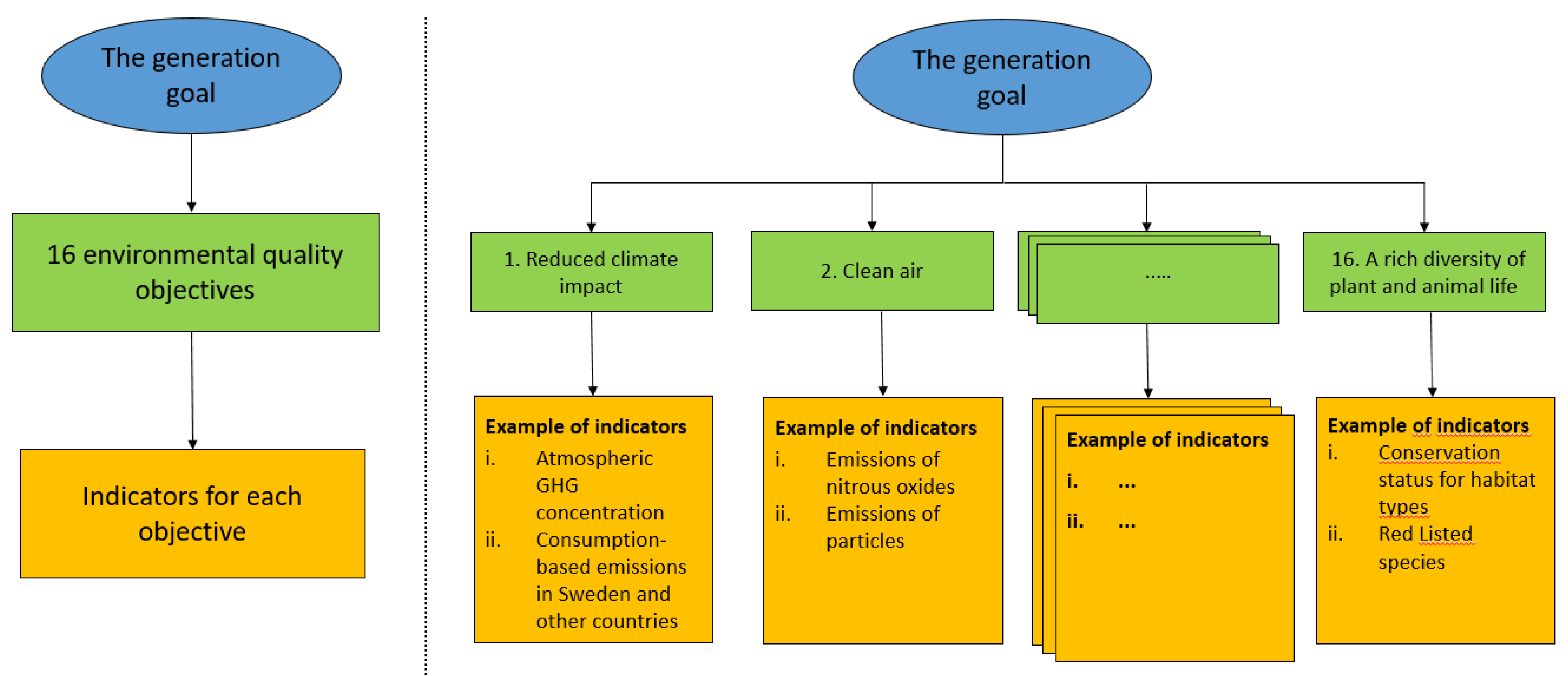
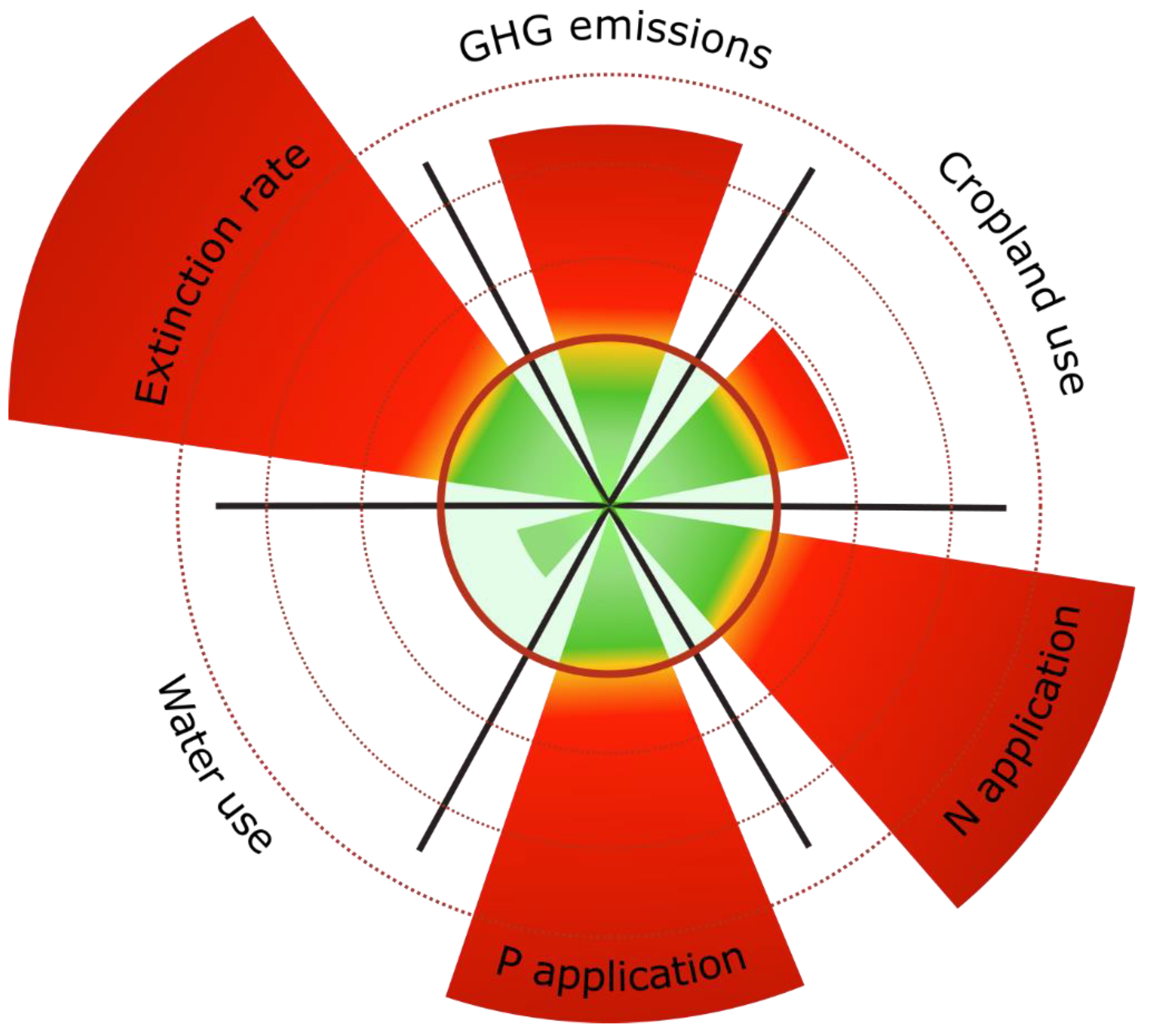
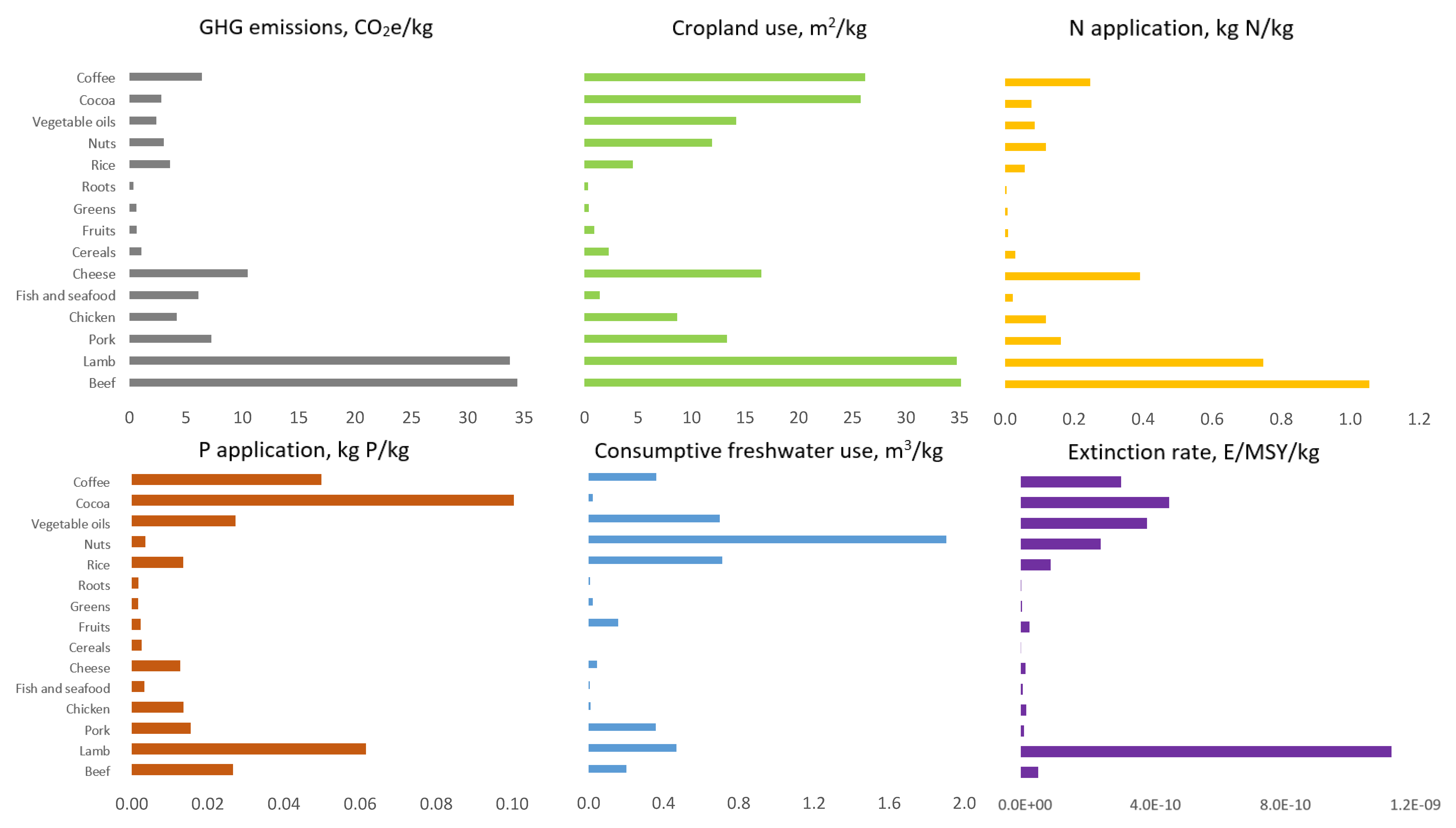
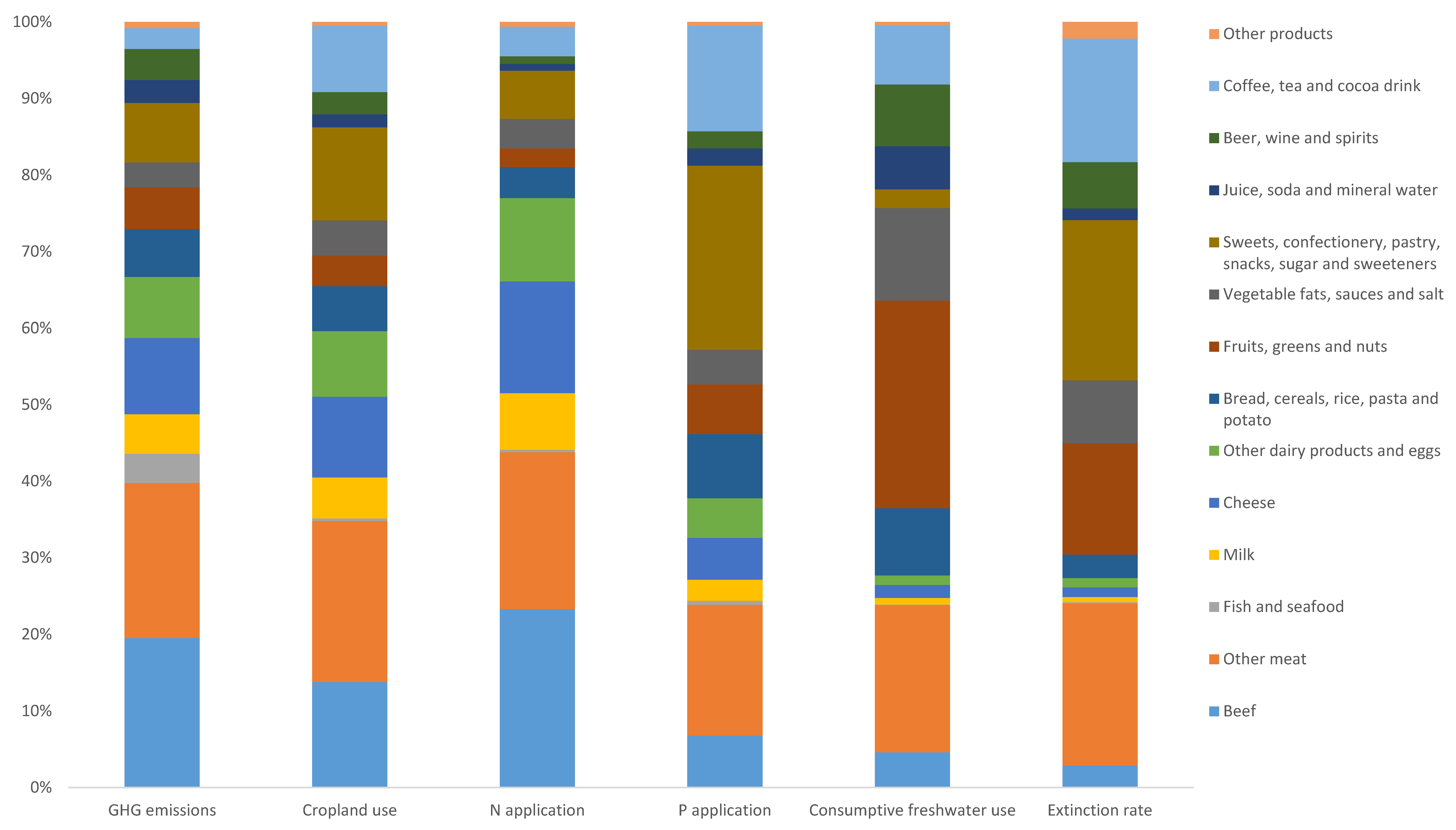
| Earth System Process | Climate Change | Land-System Change | Nitrogen (N) Cycling | Phosphorus (P) Cycling | Freshwater Use | Biodiversity Loss |
|---|---|---|---|---|---|---|
| Control variable | GHG emissions | Cropland use | N application | P application | Consumptive water use | Extinction rate |
| Global boundary | 5 Gton CO2e per year (4.7–5.4) * | 13 million km2 (11–15) | 90 Tg N per year (65–130) | 8 Tg P per year (6–16) | 2500 km3 per year (1000–4000) | 10 E/MSY (1–80) |
| Earth System Process | Climate Change | Land-System Change | Nitrogen (N) Cycling | Phosphorus (P) Cycling | Freshwater Use | Biodiversity Loss |
|---|---|---|---|---|---|---|
| Control variable | Greenhouse gas emissions | Cropland use | N application | P application | Consumptive water use | Extinction rate |
| Environmental impact per capita (results from this study) | 2.2 ton CO2e per year of which 0.92 ton CO2, 0.82 ton CH4 *, 0.5 ton N2O * and 0.01 ton HCFC-22 *. | 0.34 ha | 57 kg N per year | 5.0 kg P per year | 55 m3 per year | 8.3 × 10−9 E/MSY ** |
| Per capita boundary (downscaled from the global boundaries given by the EAT-Lancet Commission) | 0.68 ton CO2e per year for CH4 and N2O and zero for CO2 from fossil fuels and land use and land use change (0.68–0.73) | 0.18 ha (0.15–0.2) | 12 kg N per year (8.8–18) | 1.1 kg P per year (0.8–2.2) | 339 m3 per year (136–542) | 1.4 × 10−9 E/MSY (1.4 × 10−10–1.1 × 10−8) |
| Earth System Process | Aspects in the SEO not Covered by the EAT-Lancet Framework and Other Aspects Covering Environmental Sustainability | Suggested Indicator | Need for Additional Data or Method Development |
|---|---|---|---|
| Climate change | - | GHG emissions | - |
| Land-system change | Maintain Swedish agricultural land, quality aspects of land use | Swedish agricultural land and soil fertility aspects | System for monitoring soil fertility that can be connected to foods. Soil organic content could potentially be used. |
| Maintain Swedish pasture, including semi-natural pastures | Pasture use | Improved statistics on different land types and uses of pasture | |
| Nitrogen and phosphorus cycling | Site-dependent eutrophication impacts, i.e., emissions to specific catchments and nutrient status of recipients | Site-dependent eutrophication impacts | Data on emission intensities for specific catchments and on nutrient status of recipients |
| Freshwater use | Site-dependent impacts of consumptive freshwater use | Site-dependent consumptive freshwater impacts | Data on consumptive freshwater use and availability on catchment level |
| Biodiversity loss | Local aspects of biodiversity, e.g., state of threatened species on agricultural land | Terrestrial extinction rate | Methods that allow local impacts to be linked to foods |
| Marine extinction | Marine extinction rate | Methods that allow local impacts to be linked to foods | |
| Atmospheric aerosols | Air pollution | Emissions of NOx and particles | - |
| Acidification of freshwater and land | Acidification of freshwater and land | Emissions of ammonia | - |
| Chemical pollution | Toxic substances to the environment | Pesticide use | Data on the type and amount of pesticides used for different crops, especially for outside the European Union. Methods like UseTox [92] can then be applied. |
| Ozone depletion | Emissions of ozone depleting substances | Emissions of N2O | - |
© 2020 by the authors. Licensee MDPI, Basel, Switzerland. This article is an open access article distributed under the terms and conditions of the Creative Commons Attribution (CC BY) license (http://creativecommons.org/licenses/by/4.0/).
Share and Cite
Moberg, E.; Karlsson Potter, H.; Wood, A.; Hansson, P.-A.; Röös, E. Benchmarking the Swedish Diet Relative to Global and National Environmental Targets—Identification of Indicator Limitations and Data Gaps. Sustainability 2020, 12, 1407. https://doi.org/10.3390/su12041407
Moberg E, Karlsson Potter H, Wood A, Hansson P-A, Röös E. Benchmarking the Swedish Diet Relative to Global and National Environmental Targets—Identification of Indicator Limitations and Data Gaps. Sustainability. 2020; 12(4):1407. https://doi.org/10.3390/su12041407
Chicago/Turabian StyleMoberg, Emma, Hanna Karlsson Potter, Amanda Wood, Per-Anders Hansson, and Elin Röös. 2020. "Benchmarking the Swedish Diet Relative to Global and National Environmental Targets—Identification of Indicator Limitations and Data Gaps" Sustainability 12, no. 4: 1407. https://doi.org/10.3390/su12041407
APA StyleMoberg, E., Karlsson Potter, H., Wood, A., Hansson, P.-A., & Röös, E. (2020). Benchmarking the Swedish Diet Relative to Global and National Environmental Targets—Identification of Indicator Limitations and Data Gaps. Sustainability, 12(4), 1407. https://doi.org/10.3390/su12041407




